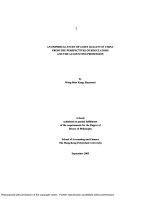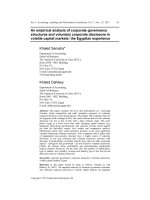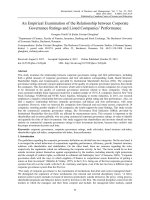Empirical studies of consumer online shopping behavior
Bạn đang xem bản rút gọn của tài liệu. Xem và tải ngay bản đầy đủ của tài liệu tại đây (283.29 KB, 112 trang )
EMPIRICAL STUDIES OF CONSUMER ONLINE
SHOPPING BEHAVIOR
LIU XIAO
(B.Sc.(Hons.), NUS)
A THESIS SUBMITTED
FOR THE DEGREE OF MASTER OF SCIENCE
DEPARTMENT OF INFORMATION SYSTEMS
NATIONAL UNIVERSITY OF SINGAPORE
2004
EMPIRICAL STUDIES O F CONSUMER ONLINE S HOPPING B EHAVIOR
ACKNOWLEDGEMENTS
______________________________________________________________
ACKNOWLEDGEMENTS
I would like to express my deepest appreciation to Prof. WEI Kwok Kee, my
supervisor, for giving me the free reins to explore my interests in IS research,
for his guidance, patience, concern and advice throughout my entire research
study, for his encouragement and support in my personal and professional
endeavors. This thesis would never have been possible without his
encouragement and valuable comments.
I am also grateful for everyone who has helped me in a way or another.
Last, but not least, I am incredibly thankful for my family for their continuous
support. This thesis is especially dedicated to them.
__________________________________________________________________
-i-
EMPIRICAL STUDIES O F CONSUMER ONLINE S HOPPING B EHAVIOR
T ABLE OF CONTENTS
_____________________________________________________________________
T ABLE OF C ONTENTS
Acknowledgement ----------------------------------------------------------------------
i
Table of Contents -----------------------------------------------------------------------
ii
Summary ----------------------------------------------------------------------------------
vi
List of Tables -----------------------------------------------------------------------------
viii
List of Figures ----------------------------------------------------------------------------
ix
Chapter 1 Introduction ----------------------------------------------------------------
1
1.1 Background … … … … … … … … … … … … … … … … … … … … … … … … …
1
1.1.1 The potential of electronic commerce … … … … … … … … … … .
1
1.1.2 The importance of online shopping in E-c o m m e r c e … … … … .
2
1.2 Research Objectives and Research Questions … … … … … … … … … …
3
1.3 The Relationships Among Three Studies ………………………………..
12
1.4 Organization of Thesis … … … … … … … … … … … … … … … … … … … … .
14
Chapter 2 Study One – Perceived Risk in Electronic Commerce ----
16
2.1 Perceived Risk in Electronic Commerce …………………………………
17
2.2 Literature and Hypotheses … … … … … … … … … … … … … … … … … … . .
18
2.2.1 P e r c e i v e d r i s k … … … … … … … … … … … … … … … … … … … … .
18
2.2.2 The criterion dimensions of perceived risk ……………………. 19
2.3 Research Methodology … … … … … … … … … … … … … … … … … … … … .
24
2.3.1 Operationalization of constructs ………………………………..
24
__________________________________________________________________
- ii -
EMPIRICAL STUDIES O F CONSUMER ONLINE S HOPPING B EHAVIOR
T ABLE OF CONTENTS
_____________________________________________________________________
2 . 3 . 2 S u r v e y a d m i n i s t r a t i o n … … … … … … … … … … … … … … … … … 26
2.4 Data Analyses and Results … … … … … … … … … … … … … … … … … … ..
26
2.4.1 Evaluating the measurement model … … … … … … … … … … …
27
2.4.2 Evaluating the structure model … … … … … … … … … … … … …
30
2.5 Discussions and Implications … … … … … … … … … … … … … … … … … . .
32
2.5.1 Perceived risk and risk dimensions ……………………………. 32
2.5.2 Perceived risk and intention to adopt E-commerce …………..
34
2.6 Conclusion … … … … … … … … … … … … … … … … … … … … … … … … … ..
35
Chapter 3 Study Two – Product Differences in Consumer’s Ecommerce Adoption Behavior ------------------------------------------------------
36
3.1 Introduction … … … … … … … … … … … … … … … … … … … … … … … … … .
36
3.2 Prior Literature on Product Differences … … … … … … … … … … … … … .
37
3.2.1 Differences between goods (physical products) and services
in the traditional shopping environment and their differences in the
E-c o m m e r c e e n v i r o n m e n t … … … … … … … … … … … … … … … … … ..
37
3.2.2 Intangibility … … … … … … … … … … … … … … … … … … … … … . .
38
3.2.3 Inseparability … … … … … … … … … … … … … … … … … … … … . ..
38
3.2.4 Heterogeneity … … … … … … … … … … … … … … … … … … … … .
40
3.2.5 Perishability ……………………………………………………….
41
3.3 Theoretical Model and Hypotheses … … … … … … … … … … … … … … …
42
3.3.1 Perceived usefulness … … … … … … … … … … … … … … … … …
42
3.3.2 Perceived ease of use …………………………………………..
43
3.3.3 Perceived risk …………………………………………………….
44
3.4 Research Design and Methodology ……………………………………...
47
__________________________________________________________________
- iii -
EMPIRICAL STUDIES O F CONSUMER ONLINE S HOPPING B EHAVIOR
T ABLE OF CONTENTS
_____________________________________________________________________
3.4.1 P r o d u c t t y p e … … … … … … … … … … … … … … … … … … … … … 48
3.4.2 S u b j e c t s … … … … … … … … … … … … … … … … … … … … … … . . .
48
3.4.3 Constructs and Questions ………………………………………
49
3.5 D a t a A n a l y s e s a n d R e s u l t s … … … … … … … … … … … … … … … … … … .
49
3.5.1 Evaluating the measurement model … … … … … … … … … … …
50
3.5.2 Evaluating the structural model … … … … … … … … … … … … …
52
3.6 D i s c u s s i o n a n d I m p l i c a t i o n s … … … … … … … … … … … … … … … … … …
57
3.6.1 Discussion of findings ……………………………………………
57
3.6.2 Implications for practice …………………………………………
58
3.6.3 Limitations of this study and implications for future research .
61
3.7 Conclusion … … … … … … … … … … … … … … … … … … … … … … … … … ..
61
Chapter 4 Study Three – A Model of Consumer Online Purchase
Intention ------------------------------------------------------------------------------------
63
4.1 Introduction … … … … … … … … … … … … … … … … … … … … … … … … … .
64
4.2 Literature and Hypotheses … … … … … … … … … … … … … … … … … … . .
65
4.2.1 Perceptions on products in online shopping environment … ..
65
4.2.2 Perceptions on online shopping in E-commerce environment
68
4.2.3 A model of consumers’online purchase intention … … … … …
72
4.3 Research Methodology … … … … … … … … … … … … … … … … … … … … .
72
4.3.1 Operationalization of constructs ………………………………..
72
4.3.2 Survey Administration ……………………………………………
74
4.4 Data Analyses and Results … … … … … … … … … … … … … … … … … … ..
74
4.4.1 Evaluating the Measurement Model … … … … … … … … … … …
75
4.4.2 Evaluating the Structure Model … … … … … … … … … … … … …
78
__________________________________________________________________
- iv -
EMPIRICAL STUDIES O F CONSUMER ONLINE S HOPPING B EHAVIOR
T ABLE OF CONTENTS
_____________________________________________________________________
4.5 Discussions and Implications … … … … … … … … … … … … … … … … … . . 79
4.5.1 Perceived value … … … … … … … … … … … … … … … … … … … ..
79
4.5.2 Perceived usefulness … … … … … … … … … … … … … … … … …
80
4.5.3 Perceived ease of use … … … … … … … … … … … … … … … … . .
81
4.5.4 Perceived risk … … … … … … … … … … … … … … … … … … … … .
82
4.6 Conclusion … … … … … … … … … … … … … … … … … … … … … … … … … ..
83
Chapter 5 Concluding Remarks ----------------------------------------------------
85
5.1 Contribution to Theory … … … … … … … … … … … … … … … … … … … … . .
85
5.2 Impl i c a t i o n s t o P r a c t i c e … … … … … … … … … … … … … … … … … … … … . 88
5.3 Limitations and Future Research … … … … … … … … … … … … … … … …
89
5.4 The Potential of Online Shopping … … … … … … … … … … … … … … … ...
90
Reference ----------------------------------------------------------------------------------
92
__________________________________________________________________
- v-
EMPIRICAL STUDIES O F CONSUMER ONLINE S HOPPING B EHAVIOR
S UMMARY
_____________________________________________________________________
SUMMARY
This study focuses on consumer behavior in the online shopping environment.
It seeks answers to three main research questions:
1. What are the criteria dimensions of perceived risk in the online
shopping environment?
2. Will consumers behave differently for services and goods in the online
shopping environment?
3. What are the antecedents of consumers’online purchase intention?
A survey of existing consumer online shopping behavior literature and
relevant marketing and information systems literature is conducted to build the
theoretical and conceptual foundation for this study. Based on the survey,
research models and research hypotheses are formulated and developed for
subsequent empirical testing.
Experiential surveys are employed to test the research hypotheses. The major
findings of this study are:
1. There are eight criteria dimensions of perceived risk in E-commerce,
namely, financial, social, time, performance, physical, privacy, security,
psychological.
__________________________________________________________________
- vi -
EMPIRICAL STUDIES O F CONSUMER ONLINE S HOPPING B EHAVIOR
S UMMARY
_____________________________________________________________________
2. Product type has significant moderating effects over the relationships
between perceived risk and consumers’ E-commerce adoption
intention, perceived ease of use and consumers’E-commerce adoption
intention.
3. Perceived value of products, perceived risk, perceived usefulness and
perceived ease of use of online shopping are important antecedents of
consumers’online purchase intention.
These findings suggest that
1. Companies should have more risk reduction activities as perceived risk
could strongly influence consumers’online purchase decisions. And
specific types of perceived risk should be taken care of in different
scenarios.
2. Companies in product business and services business should pay
attention to the effects of different products in consumers’E-commerce
adoption decision making. Perceived ease of use and perceived risk
should be paid additional attention.
3. Companies should improve consumers’ value perceptions about the
products and reduce consumers’perceived risk in the online shopping
environment. Improving the design of website and the design of risk
reduction activities would be possible solutions.
__________________________________________________________________ - vii -
EMPIRICAL STUDIES O F CONSUMER ONLINE S HOPPING B EHAVIOR
LIST OF T ABLES
_____________________________________________________________________
LIST OF T ABLES
Table 1.1
Total E-commerce Revenues in Asia, 2001-2004
2
Table 2.1
Definition of Eight Dimensions of Risk
21
Table 2.2
Operationalization of Constructs
25
Table 2.3
Results of Convergent Validity Tests
28
Table 2.4
Results of Factor Analysis
29
Table 2.5
Shared Variance (Variance Extracted) Among Constructs
30
Table 2.6
Results of Hypothesis (H1) Test
31
Table 2.7
Results of Hypothesis (H2) Test
31
Table 3.1
Results of Convergent Validity Tests
51
Table 3.2
Results of Factor Analysis
52
Table 3.3
Shared Variance (Variance Extracted) Among Constructs
52
Table 3.4
Results of Hypotheses Test (Note: *p<0.01)
54
Table 4.1
Operationalization of Constructs
73
Table 4.2
Results of Convergent Validity Tests
76
Table 4.3
Results of Factor Analysis
77
Table 4.4
Shared Variance (Variance Extracted) Among Constructs
78
Table 4.5
Results of Hypotheses Test
79
__________________________________________________________________ - viii -
EMPIRICAL STUDIES O F CONSUMER ONLINE S HOPPING B EHAVIOR
LIST OF FIGURES
_____________________________________________________________________
LIST OF F IGURES
Figure 1.1
A Model of Factors Influencing A Consumer’s Buying
4
Behavior (Kotler et. al, 1999)
Figure 1.2
The Proposed Research Model Summarizing Three
12
Studies in This Thesis
Figure 2.1
A Proposed Model for Eight Dimensions of Perceived Risk
24
Figure 3.1
The Theoretical Model
47
Figure 3.2
Structural Model for Combined Dataset
55
Figure 3.3
Structural Model for Goods
56
Figure 3.4
Structural Model for Services
56
Figure 3.5
Summary of Results
57
Figure 4.1
The Proposed Model of Consumers’ Online Purchase
72
Intention
__________________________________________________________________
- ix -
EMPIRICAL STUDIES O F CONSUMER ONLINE S HOPPING B EHAVIOR
C HAPTER 1
_____________________________________________________________________
CHAPTER 1
INTRODUCTION
1.1 BACKGROUND
1.1.1 Potential of Electronic Commerce
Most surveys indicate that Internet will continue to boom in the next few years,
especially the number of Internet users will grow rapidly. According to a
survey conducted by Computer Industry Almanac Inc. 1 in 2002, the number of
worldwide Internet users will reach 1.46 billion by year-end 2007. In AsiaPacific region particularly, most studies reveal that the number of Internet
users in the Asia-Pacific region will grow more rapidly. For instances, the
Computer Industry Almanac Inc. estimates that the Asia-Pacific region will
account for a total of 612 million users expected online by 2007.
With the forecast of rapid growth of Internet, most of studies predict that AsiaPacific region’s electronic commerce revenues will continue to grow in the
next few years. The projection of eMarketer
2
(2000) indicates that “E-
commerce revenues in the Asia-Pacific region are expected to explode”. As
shown in Table 1.1, it predicts that revenues generated in electronic
1
2
/>
__________________________________________________________________
-1-
EMPIRICAL STUDIES O F CONSUMER ONLINE S HOPPING B EHAVIOR
C HAPTER 1
_____________________________________________________________________
commerce in Asia-Pacific will rise from approximately $76.8 billion by yearend 2001, to more than $338 billion by the end of 2004.
Table 1.1 Total E-commerce Revenues in Asia, 2001-2004 (Note: in billion)
(Source: eMarketer.com, 2000)
E-commerce
2001
2002
2003
2004
76.8
135.9
225.7
338.6
1.1.2 The Importance of Online Shopping in Electronic Commerce
With the advances in the technology of networking, multimedia, data
processing, electronic commerce brings new business opportunities for
companies. Companies are spending millions of time and money in building
new Internet business models and finding new channels for their revenues.
E-commerce, at the same time, offers specific benefits to online shoppers.
Consumers not only have a more convenient way of shopping and have more
choices, but also could interact with others and exchange ideas, views
through online communities.
With the benefits recognized by companies and consumers, E-commerce has
been realized more and more important. It is believed that it will become an
important channel for business revenues and as well as an important part of
peoples’daily life.
__________________________________________________________________
-2-
EMPIRICAL STUDIES O F CONSUMER ONLINE S HOPPING B EHAVIOR
C HAPTER 1
_____________________________________________________________________
1.2 RESEARCH OBJECTIVES AND RESEARCH QUESTIONS
Realizing the importance of E-commerce, companies would like to discover
more business opportunities and to bring back more customers. As such, it is
very important to understand consumers’E-commerce adoption behavior and
their online shopping behavior. This is believed to be different from their
behavior in the traditional shopping environment. Thus, there is a need for the
theory of consumer online shopping behavior.
In the consumer behavior research literature for the traditional shopping
environment, researchers suggested that there are different groups of factors
influencing a consumer’s buying behavior. Kotler et al. ‘s (1999) framework
best described all these factors, namely, cultural factors, social factors,
personal factors and psychological factors (Kotler et al., 1999). Figure 1.1
shows the framework proposed by Kotler et al. (1999), which is summarizing
the factors influencing a consumer’s buying behavior.
This framework best described the different groups of factors influencing
consumers’ buying behavior and also built the foundation for consumer
behavior research. Tremendous of research works in studying consumer
behavior were in line with this framework.
In the new market created by Internet, consumers find the new way of making
their purchases. This new virtual market will bring significant different
experiences to consumers. As such, in the online shopping environment,
although the four groups of factors are still influencing consumers’buying
__________________________________________________________________
-3-
EMPIRICAL STUDIES O F CONSUMER ONLINE S HOPPING B EHAVIOR
C HAPTER 1
_____________________________________________________________________
behavior, it is obvious that the way of influencing, i.e., how these factors
influence consumer online shopping behavior, will differ from that in the
traditional shopping environment. Therefore, there are compelling needs for
studying consumer online shopping behavior and the influences of different
groups of factors.
Cultural Factors
Social Factors
A Consumer’s Buying
Behavior
Personal Factors
Psychological Factors
Figure 1.1 A Model of Factors Influencing A Consumer’s Buying Behavior (Kotler
et. al, 1999).
According to the framework proposed by Kotler et al. (1999), there would be
possibly four exciting research areas studying the influences of different
groups of factors on consumer online shopping behavior.
Firstly, the influence of cultural factors on consumer online shopping behavior
will differ from that in the traditional shopping environment. So, to understand
__________________________________________________________________
-4-
EMPIRICAL STUDIES O F CONSUMER ONLINE S HOPPING B EHAVIOR
C HAPTER 1
_____________________________________________________________________
the cultural differences of consumer online shopping behavior becomes very
necessary and important. While culture, subculture and social class play the
important roles in consumers’purchase decision making (Kotler et al., 1999),
it is expected that consumers from different culture, subculture or social class
will have different online shopping behavior. Chau et al. (2002) revealed the
cultural differences of consumer online shopping behavior by comparing the
reactions of online consumers in U.S and Hong Kong to web sites of several
global automobile manufacturers. They stressed that “the online behaviors of
consumers are subtlety different in nature from traditional consumer behavior
due to the unique characteristics and interplay of technology and culture”
(Chau et al., 2002).
Secondly, the social influence on online consumer behavior would be different
from that on traditional consumer behavior. Thus, it would be interesting and
important to study the effects of social factors such as reference groups,
family, and social roles and statuses (Kotler et al., 1999) on a consumer’s
online shopping behavior. Limayem et al. (2000) studied the impact of
different social factors on consumers’online shopping intentions and behavior
based on the theory of planned behavior. They especially examined and
tested the construct “subjective norms”(i.e., social influence). They showed
the different effects of social factors on consumer online shopping behavior
and pointed out that “for subjective norms, while media and family influences
were significant, friends’influence did not make a difference”(Limayem et al.,
2000).
__________________________________________________________________
-5-
EMPIRICAL STUDIES O F CONSUMER ONLINE S HOPPING B EHAVIOR
C HAPTER 1
_____________________________________________________________________
Thirdly, the influence of personal characteristics on consumer online shopping
behavior would differ from that on traditional consumer behavior. In the
traditional shopping environment, a buyer’s decisions are influenced by
personal characteristics, notably the buyer’s age and life-cycle stage,
occupation, economic circumstances, lifestyle, and personality and selfconcept (Kotler et al., 1999). It is obvious that consumers’online purchase
decisions will be influenced by personal characteristics as well. However,
such influence may differ from that in the traditional shopping environment.
Thus, to understand different online shopping behaviors with different
personal characteristics would be important tasks to build the theory of
consumer online shopping behavior and to improve the services quality. For
example, it is obvious that young people will be more willing to adopt online
shopping than old people and men and women will differ in online purchase
decisions. Slyke et al. (2002), in their study of gender differences in
perceptions of web-based shopping, showed that gender is a significant
predictor of an individual’s intention to make purchases over the Web. They
also found that men perceived Web shopping more positively than women.
Fourthly, it is important to study how a person’s buying choices are further
influenced by five major psychological factors – motivation, perception,
attribution, learning and beliefs and attitudes (Kotler et al., 1999) in the online
shopping environment, which is obviously different from that in the traditional
shopping environment. This is the area realized to be the most important by
researchers (Pavlou, 2001; Kim and Prabhakar, 2000). Most of current
research studies are focusing on the effects of consumers’psychological
__________________________________________________________________
-6-
EMPIRICAL STUDIES O F CONSUMER ONLINE S HOPPING B EHAVIOR
C HAPTER 1
_____________________________________________________________________
factors on their online shopping behavior (Pavlou, 2001; Kim and Prabhakar,
2000; Cheung and Lee, 2000; Limayem et al., 2000). Among the above five
major psychological factors, perception is most popularly studied (Pavlou,
2001; Kim and Prabhakar, 2000). Perception is “the process by which an
individual selects, organizes, and interprets information inputs to create a
meaningful picture of the world”(Kotler et al., 1999). The past works explored
and studied consumers’perceived usefulness (Pavlou, 2001), perceived ease
of use (Pavlou, 2001), perceived risk (Cheung and Lee, 2000; Kim and
Prabhakar, 2000; Pavlou, 2001), perceived consequences (Limayem et al.,
2000). Most of the works focus on consumers’ perception on the online
shopping as a new shopping way. They suggested that different perceptions
about online shopping will lead to different online purchase decisions.
However, there are areas worth to study but lacking of attention from
researchers.
Firstly, it lacks of the study on the criteria dimensions of perceived risk in Ecommerce. Although current studies include perceived risk and study how risk
perception will influence consumers’online purchase decisions (Cheung and
Lee, 2000; Kim and Prabhakar, 2000; Pavlou, 2001), it is still difficult to bring
the results to practice. The practitioners find it very difficult for them to design
risk reduction activities as they are not able to identify what are risks that
consumers are facing and how they could reduce these risks. Thus, it is
necessary to explore the criteria dimensions of perceived risk to understand
different types of perceived risk in the online shopping environment. Better
__________________________________________________________________
-7-
EMPIRICAL STUDIES O F CONSUMER ONLINE S HOPPING B EHAVIOR
C HAPTER 1
_____________________________________________________________________
understandings of perceived risk in E-commerce will help practitioners to
design risk reduction activities and get more online shopping consumers.
Secondly, it lacks of the study on product differences in consumers’ Ecommerce adoption behavior. While marketing researchers ha ve long
suggested that in a traditional shopping environment, consumers would
behave differently when purchasing different products (Berkowitz et al. 1997;
Kotler and Armstrong, 2001; Kotler et al., 1999; Lusch and Lusch, 1987), it is
believed that, in the online environment, the same observation will hold, that is
to say, different products will have different effects on cons umer online
shopping behavior. The expected results would help us to understand the
different effects of different products and to understand how we could use
Internet to better present and sell different products. Companies from product
business and services business would be able to design their strategies
based on the nature of their products and effectively market their products
through the Internet channel.
Thirdly, it lacks of study of consumers’perceptions on products in the online
shopping environment and also it lacks of study of consumers’ risk
perceptions of online shopping in product business (physical goods).
Tremendous efforts have been put into the study of consumers’perceptions
on products in the traditional shopping environment. Researchers reveal the
importance of these perceptions of products on consumers' purchase decision
making (Chang and Wildt, 1994; Zeithaml, 1988). Thus, it is believed that how
consumers perceive the product sold over the Internet probably will also
__________________________________________________________________
-8-
EMPIRICAL STUDIES O F CONSUMER ONLINE S HOPPING B EHAVIOR
C HAPTER 1
_____________________________________________________________________
influence their online purchase decisions. And also it is believed that
perceived risk of online shopping is important in forming consumers’online
purchase intentions when they consider purchasing particular physical goods.
Therefore, understanding of the relationship between consumers’perceptions
on products and their online purchase decisions and understanding of the
relationship between consumers’risk perceptions of online shopping and their
online purchase decisions will definitely help practitioners to effectively and
efficiently design and market their products over the Internet and get more
online customers.
This study has following three research objectives.
Firstly, perceived risk has been realized as a very important determinant of
consumers’E-commerce adoption intention. As such, the construct “perceived
risk”has been included in a large number of empirical studies on consumers’
intention to adopt E-commerce (Kim and Prabhakar 2000; Featherman, 2001;
Pavlou, 2001). However, practitioners find it still very difficult for them to apply
the research result to the real Internet market scenario as there lacks of the
theory explaining the effects of different types of perceived risk on consumers’
online shopping behavior. Currently, only modest effort has been devoted to
examining and measuring the criterion dimensions of perceived risk in Ecommerce adoption behavior research. Risk theories need to be developed.
This study investigates the criterion dimensions of perceived risk in Ecommerce and the relationships among these dimensions.
__________________________________________________________________
-9-
EMPIRICAL STUDIES O F CONSUMER ONLINE S HOPPING B EHAVIOR
C HAPTER 1
_____________________________________________________________________
Secondly, in the marketing discipline, products could be classified into two
groups: goods and services. Marketing researchers ha ve long suggested that
consumers would behave differently when purchasing goods and services in a
traditional shopping environment (Berkowitz et al. 1997; Kotler and Armstrong,
2001; Kotler et al., 1999; Lusch and Lusch, 1987). While it is believed that, in
the online environment, the same observation will hold, only modest efforts
have been devoted to examining the effect of product type on consumers’
online shopping behavior. Hence, theories on product effects in an online
environment need to be developed. This study investigates the moderating
effects of product type on the relationships between consumers’perceptions
about E-commerce and consumers’intention to adopt E-commerce.
Thirdly, as we all know, the number of Internet users has increased
significantly over past few years. However, most of surveys indicate that the
low penetration rate of Internet shopping is common in most countries,
especially in Asia. Only a small portion of those users have actually
purchased online (Kim and Prabhakar, 2000). Why would consumers not go
for online shopping? This is the question faced by practitioners and
researchers. The stud y of consumer online shopping behavior has been
realized to be very important and carried out by many researchers (Pavlou,
2001; Kim and Prabhakar, 2000). Most of current research studies of
consumer online shopping behavior investigate the factors influencing
consumers’intention to adopt online shopping as a new purchase method
(Pavlou, 2001; Kim and Prabhakar, 2000). They focus on consumers’
perceptions about online shopping, the new way of making purchases.
__________________________________________________________________ - 10 -
EMPIRICAL STUDIES O F CONSUMER ONLINE S HOPPING B EHAVIOR
C HAPTER 1
_____________________________________________________________________
However, there is one question in our mind, even if consumers accept the
idea of online shopping, would they make actual purchases over Internet.
Would the product itself affect consumers’ online purchase intention? In
current research studies, only modest efforts have been devoted to examining
consumers’ perceptions on products. There is a knowledge gap between
consumers’shopping behavior in the traditional environment and that in the
online environment. Hence, theories on consumer online shopping behavior
need to be developed to bridge the gap. This study investigates the
antecedents of consumers’online purchase intention, especially in product
business (physical goods).
This study focuses on the issue of consumer online shopping behavior. In
particular, this study seeks answers to the following research questions:
1. What are the criteria dimensions of perceived risk in the online
shopping environment?
2. Will consumers behave differently for services and goods in the online
shopping environment?
3. What are the antecedents of consumers’online purchase intention?
Figure 1.2 shows a complete research model summarizing three studies in
this thesis.
__________________________________________________________________ - 11 -
EMPIRICAL STUDIES O F CONSUMER ONLINE S HOPPING B EHAVIOR
C HAPTER 1
_____________________________________________________________________
Perceived
Financial Risk
Perceived
Usefulness
Perceived
Social Risk
Perceived
Ease of Use
Perceived
Time Risk
Perceived
Performance Risk
Intention to purchase
the product online
Perceived
Psychological Risk
Perceived
Physical Risk
Perceived
Risk
Perceived
Value
Perceived
Privacy Risk
Perceived
Security Risk
Criterion dimension of perceived risk
Product differences in consumers’E-commerce adoption behavior
Antecedents of consumers’online purchase intention
Figure 1.2 The Proposed Research Model Summarizing Three Studies In This Thesis.
1.3 THE RELATIONSHIPS AMONG THREE STUDIES
This thesis contains three studies. These three studies are related.
When searching for the answer to the question “Why do customers not go for
electronic commerce”, we find out from literatures that perceived risk is one of
the major causes that consumers do not adopt electronic commerce. Many
researchers (Kim and Prabhakar 2000; Featherman, 2001; Pavlou, 2001) also
suggest that perceived risk is an important factor in consumer online shopping
behavior. Thus, due to the importance of risk construct and the lacks of
__________________________________________________________________ - 12 -
EMPIRICAL STUDIES O F CONSUMER ONLINE S HOPPING B EHAVIOR
C HAPTER 1
_____________________________________________________________________
studies in the area, study one is devoted to exploring the multi-dimension
structure of risk, investigating the risk dimensions and identifying different
risks in E-commerce.
After studying the important factor-perceived risk-in consumers’E-commerce
adoption behavior, we want to have a clear and complete picture on
consumer’E-commerce adoption behavior and try to find out how consumer
will accept E-commerce as a new shopping way to make their purchases from
a technology perspective. Factors are identified and research models are built
in study two. More importantly, study two tries to investigate the differences in
consumers’E-commerce adoption behavior when they consider purchasing
products (physical goods) and services. The results show that in the online
environment, consumers’ intention to adopt E-commerce is influenced by
consumers’perceived risk more strongly for goods than services. That is to
say, in product business (physical goods), perceived risk is a very important
factor of consumer E-commerce adoption behavior.
Because of the result of study two, we would further test the effects of
perceived risk on consumers’intention to purchase particular physical goods.
Additionally, we find out from marketing literature, in the traditional shopping
environment, perceived value of physical goods is a very important
determinant of consumers’purchase intention. Thus, based on previous two
studies, study three focuses on studying how consumers’risk perceptions of
online shopping and value perceptions of products will influence their online
purchase intention when they consider purchasing physical goods online.
__________________________________________________________________ - 13 -
EMPIRICAL STUDIES O F CONSUMER ONLINE S HOPPING B EHAVIOR
C HAPTER 1
_____________________________________________________________________
These three studies are all answering the questions in consumer online
shopping behavior though they are dealing with different specific areas. The
research models and hypotheses are developed step by step from study one
to the last study with emerges of new questions. Furthermore, these three
studies are all dealing with consumers’decision making. They show us a big
picture of consumer decision making behavior in the new online environment.
Thus, although each individual study is independent, they are still closely
related.
1.4 ORGANIZATION OF THESIS
This thesis comprises 5 chapters.
Chapter 1 underlines the potential of E-commerce. It briefly discusses the
importance of Internet shopping as a new shopping medium. It presents the
main research questions of this thesis.
Chapter 2 presents study one – perceived risk in E-commerce. It reviews the
risk literature in consumer behavior research. It develops the criteria
dimensions of perceived risk in E-commerce. It reports and interprets the
results from data analyzes. It also discusses the impacts for practices and
researches.
Chapter 3 presents study two – an empirical study of product differences in
consumers’E-commerce adoption behavior. It reviews the body of cons umer
behavior literature on the differences between services and goods in the
__________________________________________________________________ - 14 -
EMPIRICAL STUDIES O F CONSUMER ONLINE S HOPPING B EHAVIOR
C HAPTER 1
_____________________________________________________________________
traditional shopping environment. It develops the hypotheses about the
product differences in consumers’E-commerce adoption behavior. It tests the
hypotheses by a survey among college students. It also provides the
interpretations and discussions about the result from data analyzes.
Chapter 4 presents study three – a model of consumers’online purchase
intention. It reviews the relevant consumer behavior literature in the traditional
marketing discipline and technology acceptance literature in the IS discipline.
It investigates the antecedents of consumers’online purchase intention. It
develops a model of consumers’online purchase intention. It discusses the
impact of this study based on the data analysis results.
Chapter 5 concludes this thesis. It summarizes the research results for the
three studies in the previous chapters. It lists the strengths and limitations of
this study. It also discusses the implications for practice and research. It ends
this thesis by exploring the potential of online shopping in the future.
__________________________________________________________________ - 15 -
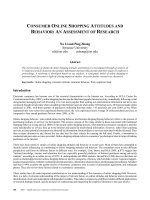
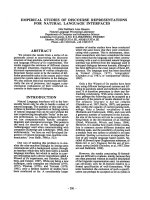
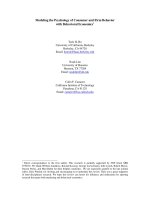


![chung - 2004 - selective mandatory auditor rotation and audit quality - an empirical investigation of auditor designation policy in korea [mar]](https://media.store123doc.com/images/document/2015_01/06/medium_bpj1420548143.jpg)
